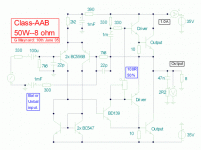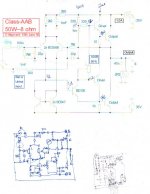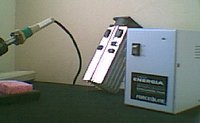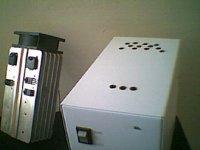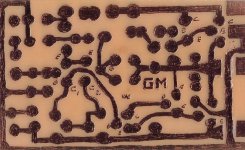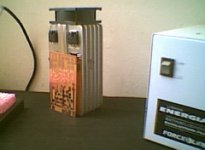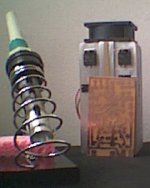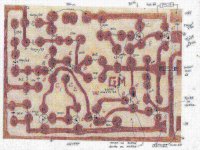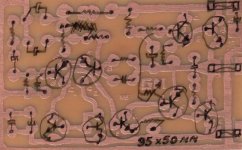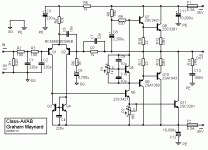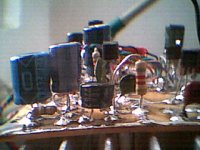Hi Hugh,
What an incredible length of time it has taken me to come up with such a simple circuit.
I have run it with a VN66AFD voltage amplifier (10th June page) which simulates with much higher open loop gain and thus extremely low closed loop thd. I did not make direct A-B comparisons, but did not notice any real advantage. However this driver does make the output stage become slightly inductive and increases first cycle distortion, thus I choose to stick with bipolar and be reassured that the transient response is excellent and damping control more phase coherent.
I might look at this further, but then I ask myself if it will be worth it because I now have other more significant problems to solve - like source and speakers.
I think Carlos feels like me here, ie. don't mess with it - it is already good, though any suggestions for improvements or variation will be viewed and/or tested with genuine interest, for this 'Diamond' as Carlos puts it, has only just been uncovered.
Simulation shows that a wide range of bias conditions will still provide good results, but my intuitively chosen values give excellent real life performance. The class-A provides sufficient continuous damping until NFB assistance is provided via the class-AB output stage, and as before I have gone for 2 degree limits for phase accuracy between 20Hz and 20kHz, which is aided by the 600 ohm input.. This gives bass instruments real firmness and voices a detailed delicacy. The AB bias can be backed right off so that the circuit acts more like a 'dumper' instead of a 'helper', but I'm not interested in that.
I also tried theoretically superior balanced inputs, but in real life ( and quite different to simulated results ) this impinged upon amplifier stabilty margin This was not worth the risk.
I tried Susan's zero global feedback transformer/Mosfet arrangement, and it really does reproduce extremely smoothly, but for me the lack of low frequency phase coherence and hf detail put me back to expanding upon JLH class-A basics.
Hi Carlos,
I have never come across anyone who builds and tries as many amplifiers as you, and so quickly too !!!
If you lived near Mauro, all our amplifier problems would soon be sussed out.
I am honoured that you have not yet found reason to write that it is 'already in bits', 'in the bin' or 'got the 12 bore' !
I now see that you bring all wires to the pcb - this might be the cause of your oscillation.
My pcb has only four small transistors.
The VAS transistor is deliberately allowed to warm up on the main heatsink to increase its gain.
I have only five wires going from pcb to heatsink. Two thick for power rails. One thick for output. One thin input to VAS. One thin from bootstrap to positive driver. All are kept spaced appart to prevent any unexpected cross-coupling.
Hi Mauro,
This amplifier (she) does well in the known to be unrealistic simulation tests I proposed, ie. examination of a first suddenly starting forward sinewave cycle at 10kHz; reverse injected damping examination, also a suddenly starting reverse injected 10kHz sinewave.
Thus I expected it to cope well with real audio requirements, and it does.
I do not have a clue whether this circuit will come out well in your tests, but its loudspeaker reproduction is good, so it must have something going for it. At least it is something different to add to our selection.
I am taking a break from all the hypotheticals at the moment, but I noticed that reproduction comments were not related to electrostatic loudspeaker types, where the driving requirements are completely different and driver back-EMFs are not a problem.
Some amplifiers are good with electrostatics but not with dynamic loudspeakers, and vice-versa; so an amplifier that is said to be good, should have the loudspeaker type tabulated too.
Cheers ........... Graham.
What an incredible length of time it has taken me to come up with such a simple circuit.
I have run it with a VN66AFD voltage amplifier (10th June page) which simulates with much higher open loop gain and thus extremely low closed loop thd. I did not make direct A-B comparisons, but did not notice any real advantage. However this driver does make the output stage become slightly inductive and increases first cycle distortion, thus I choose to stick with bipolar and be reassured that the transient response is excellent and damping control more phase coherent.
I might look at this further, but then I ask myself if it will be worth it because I now have other more significant problems to solve - like source and speakers.
I think Carlos feels like me here, ie. don't mess with it - it is already good, though any suggestions for improvements or variation will be viewed and/or tested with genuine interest, for this 'Diamond' as Carlos puts it, has only just been uncovered.
Simulation shows that a wide range of bias conditions will still provide good results, but my intuitively chosen values give excellent real life performance. The class-A provides sufficient continuous damping until NFB assistance is provided via the class-AB output stage, and as before I have gone for 2 degree limits for phase accuracy between 20Hz and 20kHz, which is aided by the 600 ohm input.. This gives bass instruments real firmness and voices a detailed delicacy. The AB bias can be backed right off so that the circuit acts more like a 'dumper' instead of a 'helper', but I'm not interested in that.
I also tried theoretically superior balanced inputs, but in real life ( and quite different to simulated results ) this impinged upon amplifier stabilty margin This was not worth the risk.
I tried Susan's zero global feedback transformer/Mosfet arrangement, and it really does reproduce extremely smoothly, but for me the lack of low frequency phase coherence and hf detail put me back to expanding upon JLH class-A basics.
Hi Carlos,
I have never come across anyone who builds and tries as many amplifiers as you, and so quickly too !!!
If you lived near Mauro, all our amplifier problems would soon be sussed out.
I am honoured that you have not yet found reason to write that it is 'already in bits', 'in the bin' or 'got the 12 bore' !
I now see that you bring all wires to the pcb - this might be the cause of your oscillation.
My pcb has only four small transistors.
The VAS transistor is deliberately allowed to warm up on the main heatsink to increase its gain.
I have only five wires going from pcb to heatsink. Two thick for power rails. One thick for output. One thin input to VAS. One thin from bootstrap to positive driver. All are kept spaced appart to prevent any unexpected cross-coupling.
Hi Mauro,
This amplifier (she) does well in the known to be unrealistic simulation tests I proposed, ie. examination of a first suddenly starting forward sinewave cycle at 10kHz; reverse injected damping examination, also a suddenly starting reverse injected 10kHz sinewave.
Thus I expected it to cope well with real audio requirements, and it does.
I do not have a clue whether this circuit will come out well in your tests, but its loudspeaker reproduction is good, so it must have something going for it. At least it is something different to add to our selection.
I am taking a break from all the hypotheticals at the moment, but I noticed that reproduction comments were not related to electrostatic loudspeaker types, where the driving requirements are completely different and driver back-EMFs are not a problem.
Some amplifiers are good with electrostatics but not with dynamic loudspeakers, and vice-versa; so an amplifier that is said to be good, should have the loudspeaker type tabulated too.
Cheers ........... Graham.
The design sure looks interesting and getting a pcb may be harder than expected because the circuits are a bit "nested", right? Not from one end to the other. It will be interesting to see where this design take us.Graham Maynard said:I now see that you bring all wires to the pcb - this might be the cause of your oscillation.
I spent a long time twisting wires, my slow speed drill is damaged, was a hand work
Also i had to fix transistos, and in this case, i had to produce some insulations too.
I was very surprised that did not take too much time to finish, adjustment was fast and easy, but some care must be taken related the bias adjustment, as trimpot has not limiting resistor to avoid excess of current. When you advance control too much..current can go to 10 amps fast!... but this can be done without problem, with the inclusion of a single resistor.
I continue to listen at it with pleasure, and now it is plugged in my DVD, Pearl Harbour Movie is shaking all home glasses...this amplifier go to very deep bass reproduction, and quality is very good. When the bomb penetrated the ship floor, crossing many stages and stopping in the ship's kitchen.... you can perceive, with details, the bombs delay helical mechanics spining... all voice wonderfull, but not too much emphasized in "S" letters, also rain is rain, and claps are claps, bells sounds as bells too.
As all of you know, it is hard to perceive clapping different from rain, and without a helping image to inform you, some doubts can ocurr, as very few amplifiers can inform that to your brain....well, having that "resolution", we can say that the amplifier is fine.
Related the amplifiers published, of course related the ones i could have or construct, as i can remember, only Graham 25W, Aksa55, Symassym from MikeB and this one....Oh!, the first JLH design have to be included, naturally.
I have here one class D also...but rain are claps and claps are rain...i could not perceive difference, also Sound stage is negative...all sound appear having no deepth, separation is good and dinamics too.
Tube sound is great, and those i mentioned have some "tube" alike sound.
regards,
Carlos
Also i had to fix transistos, and in this case, i had to produce some insulations too.
I was very surprised that did not take too much time to finish, adjustment was fast and easy, but some care must be taken related the bias adjustment, as trimpot has not limiting resistor to avoid excess of current. When you advance control too much..current can go to 10 amps fast!... but this can be done without problem, with the inclusion of a single resistor.
I continue to listen at it with pleasure, and now it is plugged in my DVD, Pearl Harbour Movie is shaking all home glasses...this amplifier go to very deep bass reproduction, and quality is very good. When the bomb penetrated the ship floor, crossing many stages and stopping in the ship's kitchen.... you can perceive, with details, the bombs delay helical mechanics spining... all voice wonderfull, but not too much emphasized in "S" letters, also rain is rain, and claps are claps, bells sounds as bells too.
As all of you know, it is hard to perceive clapping different from rain, and without a helping image to inform you, some doubts can ocurr, as very few amplifiers can inform that to your brain....well, having that "resolution", we can say that the amplifier is fine.
Related the amplifiers published, of course related the ones i could have or construct, as i can remember, only Graham 25W, Aksa55, Symassym from MikeB and this one....Oh!, the first JLH design have to be included, naturally.
I have here one class D also...but rain are claps and claps are rain...i could not perceive difference, also Sound stage is negative...all sound appear having no deepth, separation is good and dinamics too.
Tube sound is great, and those i mentioned have some "tube" alike sound.
regards,
Carlos
I was thinking, how deer him be so good in design?
I have a lot of "brain" friends, also Hugh is competent as Graham is....but once, Hugh accepted that made a small mistake..... well, but Graham!.... everything he design runs well, of course, if you know him, as he dislike Miller capacitors, if something oscilate he will blame wires, batteries, conections, boards and everything but his amplifier..... the trick is to put a Miller capacitor if unit start to oscilate overheating the zobel filter.
He is lovely and Great, but were you find love you find hate!...how can he so good this way?
This time i will get him..... i found some "unstable" schematic to give a 12 bore or 12 gauge, double barrel shot!!!....ahahahaha!
The circuit is hot as a hell...this way i will use small heatsink!
To avoid guys discover that i am "preparing the results" i will put a fan over it.
To the output TIP35 will be used
To drivers will use reasonable pair...not so good 2SB1566 and 2SD2395
To Voltage amplifier, the good 2SC4793 (ahahahha!...low gain!!!)
And to differential..... BC556C and BC547C
The circuit has not Miller compensation capacitor...he is a destructor, and also a wonderfull thing when guys know how to use it, as need special material and deep tuning.... changing from 2 to 2 picofarads, the value, hearing sibilants sounds.... a kick in the bull!
This time i will get you!
Of course joking, but some true is hidden inside everything.
I will construct this one, as the one that openned the thread is already deeply tested and i could not find defects...so..could not give a shot over it!
But i have 26 of Graham's circuits.... at least one!...yeahhhh!...at least one i will SHOT!
regards,
Carlos
I have a lot of "brain" friends, also Hugh is competent as Graham is....but once, Hugh accepted that made a small mistake..... well, but Graham!.... everything he design runs well, of course, if you know him, as he dislike Miller capacitors, if something oscilate he will blame wires, batteries, conections, boards and everything but his amplifier..... the trick is to put a Miller capacitor if unit start to oscilate overheating the zobel filter.
He is lovely and Great, but were you find love you find hate!...how can he so good this way?
This time i will get him..... i found some "unstable" schematic to give a 12 bore or 12 gauge, double barrel shot!!!....ahahahaha!
The circuit is hot as a hell...this way i will use small heatsink!
To avoid guys discover that i am "preparing the results" i will put a fan over it.
To the output TIP35 will be used
To drivers will use reasonable pair...not so good 2SB1566 and 2SD2395
To Voltage amplifier, the good 2SC4793 (ahahahha!...low gain!!!)
And to differential..... BC556C and BC547C
The circuit has not Miller compensation capacitor...he is a destructor, and also a wonderfull thing when guys know how to use it, as need special material and deep tuning.... changing from 2 to 2 picofarads, the value, hearing sibilants sounds.... a kick in the bull!
This time i will get you!
Of course joking, but some true is hidden inside everything.
I will construct this one, as the one that openned the thread is already deeply tested and i could not find defects...so..could not give a shot over it!
But i have 26 of Graham's circuits.... at least one!...yeahhhh!...at least one i will SHOT!
regards,
Carlos
Attachments
Graham Maynard said:If you lived near Mauro
'Mauro' num pais tropical.
 (Jorge Ben will kill me)
(Jorge Ben will kill me)Mmm, Carlos, shouldnt the heatsink fins point the other way around
Hi Jacco, now is Jorge Ben Jor, because of numerologist advise him to change name
To have more success, the old guys (more than 70!) with genuine black hairs (still natural black) tried to change his name.
Result that he disappeared in limbus...maybe dragged by an Universe Black hole, or travelling with grass to Sdrovosvária!
hehe, really...not a good position, but the reason why is that my design department decides to put that thing horizontally inside an enclosure, having another one exaut fan...this is breathing air througth the fins...hehe...will melt everything!...will be Graham fault..... terrible i am!
Vivo num país tropical
Abençoado por Deus
E bonito por natureza
I live in a tropical country
With God's protection.
And beautifull because it's own nature
Sdrovosbaria or Sdrovosvária, is something alike "nowhere land"
regards,
Carlos
To have more success, the old guys (more than 70!) with genuine black hairs (still natural black) tried to change his name.
Result that he disappeared in limbus...maybe dragged by an Universe Black hole, or travelling with grass to Sdrovosvária!
hehe, really...not a good position, but the reason why is that my design department decides to put that thing horizontally inside an enclosure, having another one exaut fan...this is breathing air througth the fins...hehe...will melt everything!...will be Graham fault..... terrible i am!
Vivo num país tropical
Abençoado por Deus
E bonito por natureza
I live in a tropical country
With God's protection.
And beautifull because it's own nature
Sdrovosbaria or Sdrovosvária, is something alike "nowhere land"
regards,
Carlos
Parts shown over the board.
As i already explained, i use to solder over copper, but you can adapt this to create the standard board, the one with holes.
I forgot the bias trimpot, it was missed in the board and i draw the connections....put some aerial trimpot, make your adjustment...wait amplifier to reach good temperature and adjust it again.
Now remove trimpot, measure its resistance and replace it with a fixed resistor, if not exact value, use lower value than the one you measured, to reduce bias, in place of increase it.
The bias is a little high, this represents enormous heat....79 watts of heat is difficult to manage...so, some reduce may be better to control heat, and will be worst to amplifier audio reproduction....well, there are sittuations that you have to make some choice, depending the heatsinks and fan you have.
regards,
Carlos
As i already explained, i use to solder over copper, but you can adapt this to create the standard board, the one with holes.
I forgot the bias trimpot, it was missed in the board and i draw the connections....put some aerial trimpot, make your adjustment...wait amplifier to reach good temperature and adjust it again.
Now remove trimpot, measure its resistance and replace it with a fixed resistor, if not exact value, use lower value than the one you measured, to reduce bias, in place of increase it.
The bias is a little high, this represents enormous heat....79 watts of heat is difficult to manage...so, some reduce may be better to control heat, and will be worst to amplifier audio reproduction....well, there are sittuations that you have to make some choice, depending the heatsinks and fan you have.
regards,
Carlos
Attachments
Here is the board, notice that bias trimpot was missed related to copper lines
So, this trimpot must be installed some way to adjust.
After that you can replace it by a fixed resistor, this trimpot is 100 ohms unit.
I will assemble and test tomorrow morning, lasting some time to Graham evaluate boards and decisions i took.
regards,
Carlos
So, this trimpot must be installed some way to adjust.
After that you can replace it by a fixed resistor, this trimpot is 100 ohms unit.
I will assemble and test tomorrow morning, lasting some time to Graham evaluate boards and decisions i took.
regards,
Carlos
Attachments
Hi Carlos,
I check my e-mail fot the 10th June circuit - it said 'stabilisation not determined', so I hope you do not end up 'destroying something.
I did have that one running but it was an intermediate circuit, and thus would be a backwards step from the 8th Jult one.
Try 2k2 in series with VAS base.
Cheers ........... Graham.
I check my e-mail fot the 10th June circuit - it said 'stabilisation not determined', so I hope you do not end up 'destroying something.
I did have that one running but it was an intermediate circuit, and thus would be a backwards step from the 8th Jult one.
Try 2k2 in series with VAS base.
Cheers ........... Graham.
I understood Graham, this is not finished yet.
Well, i will take a look at it, if not perfect, i will change to the first amplifier published in that thread, the one is working very fine.
Thank you, this way i will not bothered with this one, having any problems will produce the earlier one.
regards,
Carlos
Well, i will take a look at it, if not perfect, i will change to the first amplifier published in that thread, the one is working very fine.
Thank you, this way i will not bothered with this one, having any problems will produce the earlier one.
regards,
Carlos
I was having a look at the schematics of Graham's amp in posts #3, #4 and #5 and thought I do another to help me understand the circuit and give me a little practice using a schematic editor. 
Anyway, I think it turned out pretty clear and I thought it may be of help to someone else.
I used Carlos's version of the schematic (single output devices) and Graham's component selection. If someone sees an error please let me know.
Anyway, I think it turned out pretty clear and I thought it may be of help to someone else.
I used Carlos's version of the schematic (single output devices) and Graham's component selection. If someone sees an error please let me know.
Attachments
Hello Greg....happy to see you here, and also the confidence in my tests results.
This amplifier is very nice.... have wonderfull deep bass, you can inject 2 hertz and see the speaker diafragm moving.
Have also impressive treble, but really natural, a think may be a little shy, as it is normal, not better than natural...our 55 produces a treble clarity that i never heard before, the effect or Hugh parts and tunning, the Australian King!
But i will elect, my vote, the UK king, Mr. Graham Maynard.
Aksa 55 produces more power, not beeing class A, also produces a little bit more dinamics, and produce less heat than Diamond Graham's amplifier.
This one, Diamond recreated, is a very Hot , and not only related heat.....voice is very good, and i think it matches 55, beeing a wonderfull combination, installing Diamond into enormous woffers and Aksa 55 to voices and trebles, but both can reproduce all spectrum very well, having each one its own better points....a five channels amplifier will be something out of the Galaxy, if used 2 AKSA 55, 2 Diamong and 1 Symassym4 made by Michael Bittner, MikeB.
MikeB is working hard very hard in Gutersloh, Germany, sleeping in his office, arbeite 18 hours each day to reach the dead line of his obligations...i am waiting his return to publish this Symassym4, because this one, the Symassym, used to subwoofer bass can go to 200 clean deep bass power and can go 1Hertz as Diamond can go (the last Graham model, he did not told me the name, this is the way i call it, so, he may appear with other name)
I tried here to produce the same treble that i have with 55 amplifiers..... i used Hugh parts...but i could not.
Diamond is perfect in treble, natural, do not emphasized absolutely nothing, but some sounds produced by 55 amplifier, as saxophone, marimba, bells, and some instruments are more than natural, are wonderfull.... to bass i jumped to Diamond...better to have all three i told you, as i already tested around 3.7K amplifiers and those are great!...but i cannot forget JLH basic designs, the first one is magnificent, the first King, infortunatelly dead...the problem is that it stay alone in its small power level, jumping out to any combination with other amplifiers...have to hear in small rooms and accept not to shake glasses or disturb neighboors, and this may be something very week for daily use.
Greg, your amplifier will work immediatelly, without any problems.... well, i have one, oscilation!!!...but Graham already told the problem may be my wires and the transistors i used as voltage amplifier, the 2SC1819..... i stopped oscilation using a 50 picofarads capacitor from base to colector , directly soldered over the voltage amplifier leads (OH!... TERRIBLE!... will say the guys that love clean assemble), i do not care about that, beauty is not so important, others qualities are more important.
My wife is beautifull as an accident, because i runned to her when i perceived what she has inside, as character qualities, was lucky to receive a pretty package to.
I did not remove capacitor, because brazilian say told me:
"Never change nothing in a team that is winning!"
Because you can go and destroy the team quality substituting one person, as the same can happen substituting one transistor or capacitor.
Symassym4:
I will have to wait Bittner return alive, ...return to have normal life, as he have to finish to pay enormous money to banks and have dead line...he will born again and i will ask him to publish his schematic...he is very shy to do it.
The last amplifier, a Graham diagram that was in development, not finished.
I decided to construct, but Graham told that was just one experience, one step into Diamond creation, and that had some adjustments to be made.
I did those adjustments, but really....aaaagh!...the amplifier has nothing to compare with diamond...i promiss to give a shot in every sh-- amplifier that i assemble, my dirty revenge, but as Graham is a very good friend, i will dismount board and construct there another P3A ( as i already made one once)....and probably will shot P3A circuit...because Rodd is not a close friend, and Graham is a close friend, so, if i dislike some board...hehe, better to be Rodd's circuit assembled there, than Graham circuit assembled over.
I made the circuit, the second one published, but really not finished as Graham told..... he told that i will go backwards, alike crab walking backwards......and crab remember me a good name to this amplifier...crab!...crab!...crab!.......ahahahha!
Please, DO NOT assemble that one, go to the first one, the finished and tested Diamond, a genuine product from the King of UK!
God bless my Kings!.... long life to the Kings!
I will show you some pictures of the crab..... it works...but is normal and standard, having nothing of special, alike thousands of amplifier you can find in web..... another grain of sand, very alike other grains of sand.
regards,
Carlos
This amplifier is very nice.... have wonderfull deep bass, you can inject 2 hertz and see the speaker diafragm moving.
Have also impressive treble, but really natural, a think may be a little shy, as it is normal, not better than natural...our 55 produces a treble clarity that i never heard before, the effect or Hugh parts and tunning, the Australian King!
But i will elect, my vote, the UK king, Mr. Graham Maynard.
Aksa 55 produces more power, not beeing class A, also produces a little bit more dinamics, and produce less heat than Diamond Graham's amplifier.
This one, Diamond recreated, is a very Hot , and not only related heat.....voice is very good, and i think it matches 55, beeing a wonderfull combination, installing Diamond into enormous woffers and Aksa 55 to voices and trebles, but both can reproduce all spectrum very well, having each one its own better points....a five channels amplifier will be something out of the Galaxy, if used 2 AKSA 55, 2 Diamong and 1 Symassym4 made by Michael Bittner, MikeB.
MikeB is working hard very hard in Gutersloh, Germany, sleeping in his office, arbeite 18 hours each day to reach the dead line of his obligations...i am waiting his return to publish this Symassym4, because this one, the Symassym, used to subwoofer bass can go to 200 clean deep bass power and can go 1Hertz as Diamond can go (the last Graham model, he did not told me the name, this is the way i call it, so, he may appear with other name)
I tried here to produce the same treble that i have with 55 amplifiers..... i used Hugh parts...but i could not.
Diamond is perfect in treble, natural, do not emphasized absolutely nothing, but some sounds produced by 55 amplifier, as saxophone, marimba, bells, and some instruments are more than natural, are wonderfull.... to bass i jumped to Diamond...better to have all three i told you, as i already tested around 3.7K amplifiers and those are great!...but i cannot forget JLH basic designs, the first one is magnificent, the first King, infortunatelly dead...the problem is that it stay alone in its small power level, jumping out to any combination with other amplifiers...have to hear in small rooms and accept not to shake glasses or disturb neighboors, and this may be something very week for daily use.
Greg, your amplifier will work immediatelly, without any problems.... well, i have one, oscilation!!!...but Graham already told the problem may be my wires and the transistors i used as voltage amplifier, the 2SC1819..... i stopped oscilation using a 50 picofarads capacitor from base to colector , directly soldered over the voltage amplifier leads (OH!... TERRIBLE!... will say the guys that love clean assemble), i do not care about that, beauty is not so important, others qualities are more important.
My wife is beautifull as an accident, because i runned to her when i perceived what she has inside, as character qualities, was lucky to receive a pretty package to.
I did not remove capacitor, because brazilian say told me:
"Never change nothing in a team that is winning!"
Because you can go and destroy the team quality substituting one person, as the same can happen substituting one transistor or capacitor.
Symassym4:
I will have to wait Bittner return alive, ...return to have normal life, as he have to finish to pay enormous money to banks and have dead line...he will born again and i will ask him to publish his schematic...he is very shy to do it.
The last amplifier, a Graham diagram that was in development, not finished.
I decided to construct, but Graham told that was just one experience, one step into Diamond creation, and that had some adjustments to be made.
I did those adjustments, but really....aaaagh!...the amplifier has nothing to compare with diamond...i promiss to give a shot in every sh-- amplifier that i assemble, my dirty revenge, but as Graham is a very good friend, i will dismount board and construct there another P3A ( as i already made one once)....and probably will shot P3A circuit...because Rodd is not a close friend, and Graham is a close friend, so, if i dislike some board...hehe, better to be Rodd's circuit assembled there, than Graham circuit assembled over.
I made the circuit, the second one published, but really not finished as Graham told..... he told that i will go backwards, alike crab walking backwards......and crab remember me a good name to this amplifier...crab!...crab!...crab!.......ahahahha!
Please, DO NOT assemble that one, go to the first one, the finished and tested Diamond, a genuine product from the King of UK!
God bless my Kings!.... long life to the Kings!
I will show you some pictures of the crab..... it works...but is normal and standard, having nothing of special, alike thousands of amplifier you can find in web..... another grain of sand, very alike other grains of sand.
regards,
Carlos
Attachments
- Status
- This old topic is closed. If you want to reopen this topic, contact a moderator using the "Report Post" button.
- Home
- Amplifiers
- Solid State
- Incredible quality amplifier by Graham, prepare your ears for it
 is very similar.
is very similar.